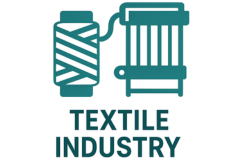TEXTILE ASIA - KARACHI 2025

ABOUT TEXTILE ASIA
The Textile Asia Exhibition in Pakistan is strategically hosted across multiple major cities, including Karachi, Faisalabad, and Lahore. This multi-city approach is crucial given these cities' pivotal roles as key hubs in Pakistan's textile industry, each contributing distinct expertise and resources to the sector.
By staging the exhibition in these diverse locations, organizers significantly enhance accessibility and encourage broader participation from various regions and stakeholders within the country's textile landscape. Karachi, serving as a major economic and industrial nexus, provides a prime venue, drawing a wide array of exhibitors and visitors from both local and international spheres. Faisalabad and Lahore, renowned for their specialized contributions to textile manufacturing, also serve as vital host cities for Textile Asia. This offers a dedicated platform for local businesses, manufacturers, and professionals from these areas to effectively showcase their products, cutting-edge technologies, and specialized services.
The overarching goal of organizing the exhibition across these three major cities is to engage a wider audience, foster robust industry networking, facilitate invaluable knowledge exchange, and stimulate business collaborations across the diverse segments of Pakistan's textile industry.
Pakistan: The Regional Textile Hub
Pakistan has long been recognized as a formidable global player in the textile industry. Its textile sector is a cornerstone of the national economy, creating extensive employment opportunities and generating substantial foreign exchange through exports. Several inherent strengths contribute to Pakistan's prominent standing as a regional textile hub:
- Abundant Cotton Production: As one of the world's leading cotton producers, Pakistan possesses a robust foundational raw material for its textile industry.
- Vertical Integration: The Pakistani textile sector is remarkably vertically integrated, encompassing the entire production chain from spinning, weaving, knitting, and processing, right through to the manufacture of finished goods.
- Competitive Manufacturing Advantage: The nation benefits from comparatively lower labor costs, making its textile manufacturing highly competitive on the international stage.
- Strong Export Orientation: Pakistan is a significant global exporter of textiles, offering a diverse portfolio including yarn, fabric, garments, and home textiles to various international markets.
- Government Support and Incentives: The government has proactively implemented a range of policies and incentives, such as tax breaks, subsidies, and infrastructure development, specifically designed to bolster the textile industry.
- Skilled Workforce: Pakistan boasts a proficient workforce within its textile sector, which directly contributes to the high quality and efficiency of its production processes.
- Technology Adoption: The industry has shown a progressive trend in adopting modern technology and machinery, leading to continuous improvements in productivity and quality.
Despite these strengths, challenges persist, including energy shortages, infrastructural limitations, compliance hurdles, and intense global market competition. Addressing these issues, while simultaneously investing further in technology, sustainability, and innovation, will be crucial for Pakistan to solidify its position as a leading regional textile hub. Furthermore, emphasizing value addition, diversifying product offerings, and enhancing supply chain efficiencies can significantly boost Pakistan's competitiveness in the global textile market.
Pakistan Textile: A General Overview
The textile industry remains an immensely significant sector in Pakistan, widely considered the backbone of its economy. It makes a substantial contribution to the country's GDP, employment figures, and export earnings.
Importance:
- Economic Contribution: Pakistan's textile industry is a major contributor to the national GDP, representing a considerable portion of the country's industrial output and critical export revenue.
- Employment: It serves as a vital source of employment, directly and indirectly providing jobs to millions across various stages of production.
- Exports: Textile products, including cotton yarn, fabrics, garments, and made-up articles, constitute a dominant share of Pakistan's total exports.
Sub-Sectors:
- Cotton Production: Pakistan stands among the largest global producers of cotton, supplying the essential primary raw material for its extensive textile industry.
- Spinning: This fundamental sub-sector transforms raw cotton into yarn.
- Weaving & Knitting: At this stage, yarn is meticulously converted into various fabrics through weaving or knitting processes.
- Garments & Made-Ups: These sectors focus on the production of finished textile goods such as clothing, home textiles, and accessories.
-
Government Initiatives:
- Incentives: The government has proactively introduced various incentives and schemes specifically aimed at supporting the textile industry, with the goal of enhancing competitiveness and boosting exports.
- Infrastructure Development: Concerted efforts are being made to improve critical infrastructure, including transportation and energy, to effectively support the industry's sustained growth.
-
Future Outlook:
- Diversification: The industry is exploring new markets and diversifying its product portfolio to reduce reliance on a few traditional export items.
- Technology Adoption: There's an increasing emphasis on embracing advanced technological innovations to significantly improve productivity, efficiency, and overall product quality.
- Sustainability: A growing focus on sustainable and eco-friendly practices is crucial to meet evolving global standards and consumer demands.
Exhibitors
No exhibitors found in this category.
